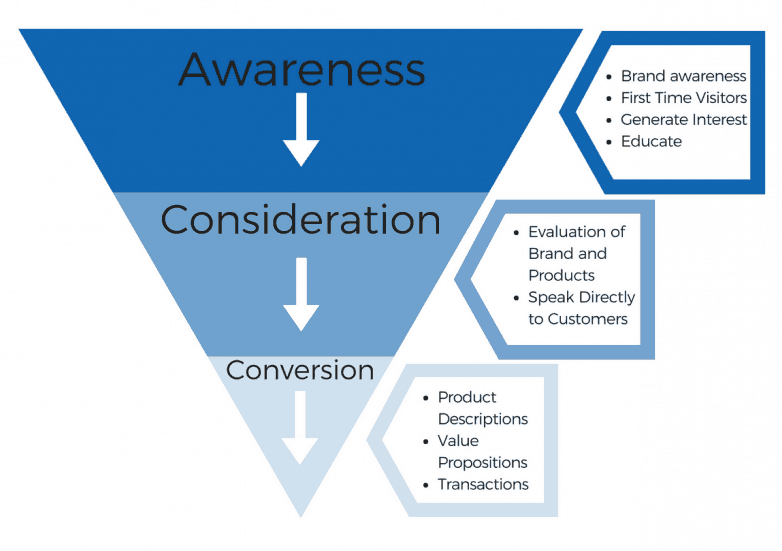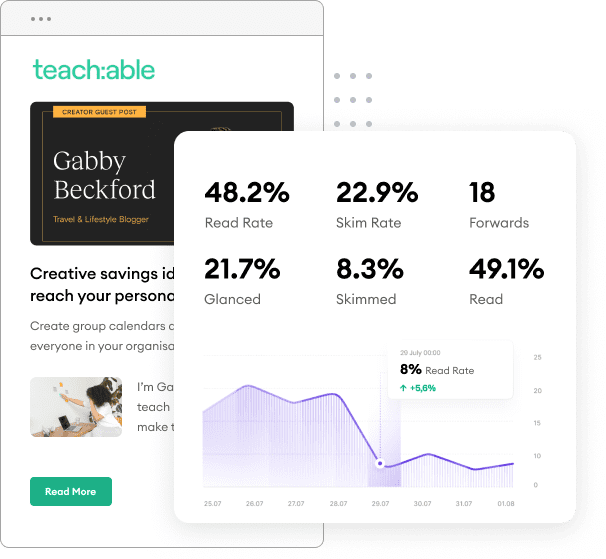Email marketing comes in all shapes and forms. It can be a simple one-time message blasted out to all your contacts, or it can be a large-scale multi-tiered campaign carefully dripped out to specific customers at key times. In order to truly understand the how, when, and why of email drip campaigns and email marketing, you should be studying the sales funnel and consumer journey. Here, we’ll go over all the steps of the funnel, and how your email drip campaign can optimize the journey.
First, let’s take a look at the consumer journey. There are many versions of this, so we’ll choose a general five-stage model.

The term funnel is a common one, as it implies large amounts enter the first phase in order for a few to finish the journey. It may be helpful to picture it as more of a circle, as later phases can actually aid the earlier ones.
The different stages of the consumer journey are what fills the sales funnel and helps your sales team how and when to reach out to leads. Ideally, through keeping the consumer journey in mind, you help new leads go through the different stages of the journey and warm these leads up for your sales team.
You should also be equipping your sales team with the right content assets that they can share with their leads to convert someone from consideration to conversion.
Let’s focus on the consumer’s journey and how your content and email efforts can move leads along the path to becoming a new client. Each phase needs a particular strategy applied to maximize effectiveness. Let’s go through the journey with the accompanying strategy, and we’ll provide some examples as well.
At a time where the consumer is unaware of your brand, you should resist the urge to push the sales tactics and self-promotional material specific to your product. Now is the time where you want to establish your brand as a thought leader and provider of solutions, so the creation of newsletters, eBooks, and informative blog posts should be a priority.
Have your newsletter and/or eBook gated, so you can start adding more email addresses to your list, and make sure to promote them on social media as well. That said, you don’t want to bombard people with emails they never wanted to receive, so make sure it’s an opt-in situation. You want to establish and build trust and expertise, and not much more.
Example: SEO giant Moz uses email drip campaigns to send wonderfully curated and informative newsletters to all their subscribers, without any pushy sales tactics. The quality of their product speaks for itself, which is pure gold for B2B marketing.
Now you’ve got their attention, and, based on their response, they are definitely interested in your product. You still want to stay away from the hard sales pitches, though, and continue to provide informative and solution-based content. You’re developing a long-term relationship here, so you want this to be increasingly personal as the campaign progresses.
This is the stage where you identify who you’re working with, and then provide them with relevant email drip campaigns that apply to them. Case studies, success stories, and maybe a few testimonials are good, but make sure you are still focused on providing solutions and building trust.
Example: PerfectAudience retargets social ads for businesses that are not seeing the results they want. By offering a case study to read, along with juicy success statistics in the email, it encourages potential customers to read that study, as well as continue on to their website to get more information.
This is what you’ve been nurturing these relationships all this time for. It’s time to close, but you still don’t want to overwhelm them with sales calls. You can still provide them with content that reassures them that they’re making the right choice. A few more success stories can provide the social proof they need to make the purchase.
Now that they’re almost part of the team, you can invite them to webinars or trickle them onboarding videos. And if you want to offer a welcome wagon discount, make sure there’s language to convey a sense of urgency like “one-time offer” or “limited availability”. That could be the final gem that makes the deal happen.
Example: Here, Grammarly flaunts a little of their social proof, citing testimonials and easy-to-digest samples of how well their service works. A prime example of how these sorts of email drip campaigns at the conversion stage can make the difference.
We are combining these phases into a single strategy because the ideas are similar. Turning away from your consumers after they’ve been converted is a big mistake; retaining existing customers is worth as much or more than getting new ones. Let them know you’re still excited about their business with entertaining and engaging monthly or weekly email drip campaigns, informative posts about how to best use your product or service, and incentives to resign with your brand early. Surveys and feedback can both reassure your customers and give you valuable market research at once.
Turning your existing customers into advocates is a worthy investment, and you can get the momentum going with the content you’re sending them. If you sent surveys, let them know how much their feedback meant, and offer them further discounts for referrals. Ask them for testimonials, and make sure that you are linking back to their awesome brand at every opportunity on social media.
You can see now how your efforts on the tail end of your funnel/circle can start moving the needle in the awareness and consideration phases at the front end. The key is to continuously provide great content, personalized messaging, and a trusted presence throughout.
Example: American Express, in one fell swoop, thanks their clients for their loyalty, offers them discounts, and invited them into a no-risk referral program. This covers all of the bases in a non-intrusive yet rewarding way.
The consumer’s journey and email drip campaigns help fill your sales funnel and it’s helpful to tag leads according to what phase they’re in for both sales and marketing so that sales knows when to call the lead and so you know what content to drip them from marketing. The goal is to steer these leads through the funnel to purchasing and then once they become a client, to keep them as a client with your awesome product and helpful content.
Do you have any tips on nurturing leads with email drip campaigns according to where they fall in the consumer’s journey? Share your tips with us on Twitter @Feed_otter
